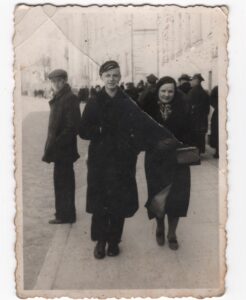Until recently, it was said that he was 13 years old. There were also those who claimed that he did not exist at all. And yet he did, and he died heroically defending Grodno from the Red Army. Still, we do not know much about him.

Grodno. Tadeusz Jasinski. Photo from the “Grupa Wschód” collection, Sybir Memorial Museum depository
He was born in 1924 in Grodno. He was the son of Zofia Jasińska, a maid. We know nothing about his father. Tadeusz lived with his mother on Bonifraterska Street. Zofia, a single mother, struggled to make ends meet. She received assistance under the city’s program for the poor. Tadzio was under the care of the Grodno Charity. Despite his poverty, he studied at high school.
When the Red Army entered the streets of Grodno, in addition to soldiers, the city was defended mainly by civilians. For three days (20-22 September 1939), scouts, schoolchildren, teachers and residents of neighboring villages fought the invaders. Young boys attacked Soviet tanks with gasoline bottles. Tadeusz managed to destroy one of them.
A witness to these clashes was Wacław Szczygielski, who described them as follows: “During these battles, more than a dozen Soviet tanks were destroyed, the wrecks of which I saw on the streets. I remember that one of these destroyed tanks was on Orzeszkowa Street. It was destroyed by my colleague, Jasiński. I don’t remember his first name. He was my friend from the street. He was 15 years old.”
However, the Soviets caught Tadeusz and – probably in revenge – tied him to another tank. In this way he became a “living shield.” During the fighting, dragged on a tank, the battered boy was shot several times. When the machine stopped, teachers Grażyna Lipińska and Danuta Bukowińska ran up to it and, despite the Red Army’s threats, freed Tadzio and carried him to the hospital. However, it was too late and the boy’s wounds were too serious. He died in the hospital on 21 September 1939.
Here is an except from Grażyna Lipińska’s book “If I ever forget them…”, published in Paris in 1988 and then several times in Poland: “On the front of a tank there is a child, a boy. Blood from his wounds is spilling over the iron. Together with Danuta, we are starting to release the boy’s arms, bound with rags. I do not realise what is going on around me. A black tank operator holding a BAP in his hand jumps out of the tank, and another behind him threatens us. With his fist raised in the Bolshevik gesture, with a scowl on his face, with a husky voice he is screaming, he is accusing us and the boy. For me, they do not exist; I can only see the eyes of the child, full of fear and torment. And I see the unleashed arms reaching out to us with boundless confidence. Danka lifts the child from the tank in one move and lays him on a stretcher. I am already at his head. We grab the stretcher and, leaving the torturers speechless with our audacity, run towards the hospital. The boy has five wounds from rifle bullets (I know these are Polish bullets) and is bleeding terribly, but he is conscious. In the hospital he is surrounded by sisters, doctors and the sick. “I want my mother”, the child wails. His name is Tadeusz Jasiński; he is 13 years old. He is the only child of Zofia Jasińska, a maid; he does not have a father, so he is a foster child of the Charity Institution. He went into the battle, he threw a bottle of gasoline at the tank, but he did not light it , he could not, he was unable to do it… They jumped out of the tank; they beat him and wanted to kill him, but then they tied him to the front of the tank. Danka brings Tadeusz’s mother. The blood transfusion is not helping. The boy is getting weaker and weaker – he is dying. But he is dying in the arms of his mother and on a patch of free Poland because the military hospital is still in our hands.”
Tadeusz Jasiński’s name was given to streets in several Polish cities; his symbolic tomb was established in Grodno, and the Hero himself was posthumously (in 2009) awarded the Commander’s Cross of the Order of Polonia Restituta.



